By Lucy Komisar
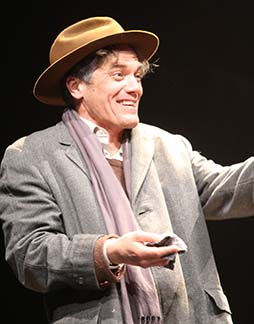
Ionesco‘s absurdist satire is a vivid dark commentary on the popular refusal to acknowledge the horrors of the rise of Naziism. And the belief of some Germans that Hitler was ushering in an era of shining, sparkling glory. They could ignore that some people were disappearing, perhaps murdered.
Director Darko Tresnjak’s staging is part straight, part bizarre, to make every line resonate in contemporary reality.
Berenger (a too na¯ve Michael Shannon), Ionesco‘s Everyman, gets off a wrong bus he rides to the last stop. A civil servant (a properly officious Robert Stanton), tells him he is in the Radiant City which he, the architect, built. He says how wonderful it is.
Berenger declares, “I just knew that in the middle of our gloomy city, right in among all our sad, dark neighborhoods full of mud and dirt, I would find this bright, beautiful area, not rich or poor, with these sunny streets, these avenues streaming with light.”
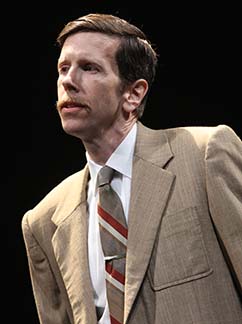
We don‘t see it – the green lawn, the flowers he remarks on. The set is an open space into which we pour our imaginations. Then the architect gets a phone call from his secretary Dennie (Stephanie Bunch) to say she is quitting. She can‘t take it. When she arrives, Berenger quickly falls in love with her.
He wants to move to the wonderful place. But the architect informs him that the people who live there want to leave. They go out only in groups of ten or fifteen. And even that doesn‘t necessarily reduce the danger.
There is a murderer stalking the populace. He kills three people a day. Everybody in the neighborhood knows him. He meets people at the bus stop in the guise of a panhandler and latches onto them. When they arrive at a lagoon, he offers to show them a photo of the Colonel. When they look over to see better, he pushes them in.
The architect invites Berenger to a café for some wine. There is a cry, and the next victim is killed. It‘s someone we know.
Shannon appears a bit too wide-eyed and flakey as Beringer, and the hour of the first act could be cut, condensed. (When the original Paris director wanted to cut the play, Ionesco refused.)
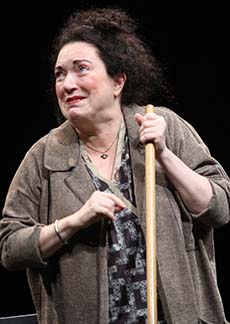
But in the second act, the symbolism thickens, or darkens. Berenger has a room in a building whose concierge (the delightful Kristine Nielsen) is a quirky, grimacing, philosophizing character. She is cantankerous: “These days, there‘s just too much education, if you ask me. That‘s why everything‘s gone downhill. Even sweepin‘ the stairs is harder than it used to be.”
Berenger discovers that everybody knows about the killings, they have for years. When he returns to his cluttered room, he discovers that his friend Edward (the excellent Paul Sparks), has somehow gained entrance. Edward is a white-faced fellow with a sharp nose, black coat and weird demeanor. Sparks creates a chilling character. Berenger tells Edward about the killings and says, “what amazes me is that you‘re no longer upset by this. I‘ve always believed that you were a sensitive, humane man.”
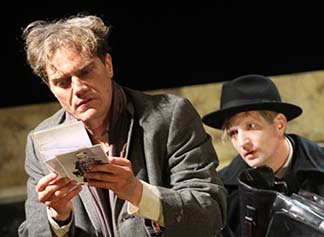
Edward has a large satchel which he clumsily knocks against a table, dumping a sheaf of photos of a colonel on the ground. Berenger notes, “It‘s an army officer with a handlebar mustache, and epaulets – a colonel with all his decorations.” He declares, “The monster‘s things! These things belong to the monster! It‘s extraordinary.” There are children‘s watches and a diary and writings of the criminal‘s philosophy.
He makes no connection to Edward. The people who saw the evidence of Hitler‘s crimes also discounted them.
Suddenly, everything comes together in a third act that begins powerfully with a rally led by Ma Piper (Nielsen) in a military uniform decked with medals. Flags have the image of a white goose. A large poster of a goose is on the wall. She declares, “You can trust me to drive the chariot of state, which is drawn by my geese. Vote for me. Put your trust in me. My geese and I claim the right to govern you….Good people, you‘ve been deluded. We‘re going to de-delude you!” Nielsen is a brilliant fascist Pied Piper, subtle, soothing, then aggressive.
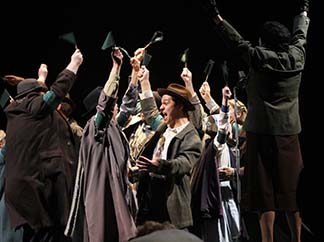
Her followers wear black arm bands emblazoned with a goose, and they punch the air in salutes. We recall that Edward wears a black armband. The crowd shouts, “Hooray for Ma Piper. Hooray for the geese.”
Ma Piper says, “I‘ll change everything. To change everything we don‘t need to change anything. We don‘t change things, we change their names. The old delusions couldn‘t stand up to psychological and sociological analysis. The new delusions will be unshakable. It will only have misunderstandings. We will perfect the lie.”
We‘re going to de-alienate humanity! To de-alienate humanity, we must alienate each individual – and there will be free soup for everybody!
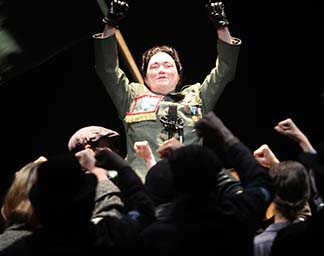
She pledges, “We will never persecute anyone, but we will punish….We will not colonize the people but occupy their lands to liberate them! ….Forced labor will be called volunteer work. War will be called peace, and everything will be changed, thanks to me and my geese!”
And suddenly, she declares, “And as for the intellectuals – We‘ll teach them to do the goose-step! Hooray for the geese!” And, “We only have to take a few steps backward to be at the forefront of history!” So now it‘s clear. Where are the protestors?
A man, a hero, comes, and says “The hero battles against his time and creates a different time.” “Down with Ma Piper” he says.
And Ma Piper declares, “Me and my geese, we‘ll distribute all public funds! We‘ll all share equally. I‘ll take the lion‘s share for myself and my geese.”
He shouts, “And freedom for critics!” Of course, they will beat him up. And the police and military arrive.
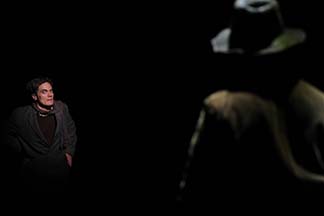
In the dénouement, Berenger finds himself alone with “the killer,” a man in a slouch hat whose face we never see, who he tries to persuade against hatred. “I‘m determined not to give up on you,” says Berenger. “We can both speak the language of reason, I thought I sensed that, the cerebral kind. You deny love, you suspect charity, they don‘t compute in your calculations, you think charity‘s just a big fraud!” Still the na¯veté of liberals. And he goes on.
This part of the play again is too long and repetitious. And the killer‘s repeated sniggering (he has no other lines) gets tiresome.
Forget such quibbles. “The Killer” is not performed frequently. If you care about political theater, you must see it.
“The Killer.” Written by Eug¨ne Ionesco; directed by Darko Tresnjak. Theatre for a New Audience at Polonsky Shakespeare Center, 262 Ashland Place, Brooklyn. (Nevins or Atlantic Avenue stops on subway.) 866-811-4111. Opened June 1, 2014; closes June 29, 2014.

